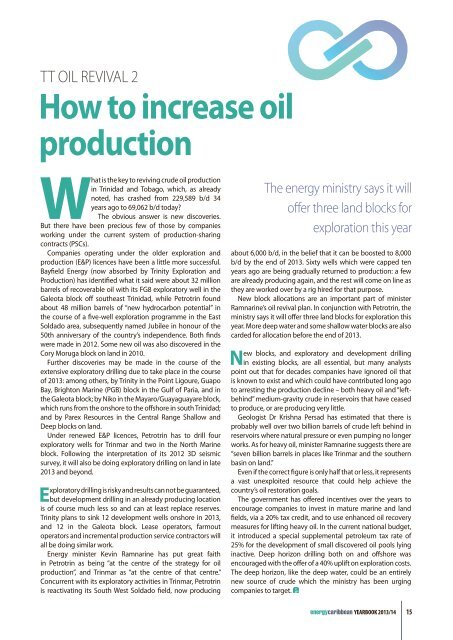ENERGY Caribbean Yearbook (2013-14)
- No tags were found...
You also want an ePaper? Increase the reach of your titles
YUMPU automatically turns print PDFs into web optimized ePapers that Google loves.
Energy<br />
tt oil revival 2<br />
issues<br />
How to increase oil<br />
production<br />
What is the key to reviving crude oil production<br />
in Trinidad and Tobago, which, as already<br />
noted, has crashed from 229,589 b/d 34<br />
years ago to 69,062 b/d today?<br />
But there have been precious few of those by companies<br />
working under the current system of production-sharing<br />
contracts (PSCs).<br />
Companies operating under the older exploration and<br />
production (E&P) licences have been a little more successful.<br />
Bayfield Energy (now absorbed by Trinity Exploration and<br />
Production) has identified what it said were about 32 million<br />
barrels of recoverable oil with its FG8 exploratory well in the<br />
Galeota block off southeast Trinidad, while Petrotrin found<br />
The obvious answer is new discoveries.<br />
Compani<br />
about 48 million barrels of “new hydrocarbon potential” in<br />
the course of a five-well exploration programme in the East<br />
Soldado area, subsequently named Jubilee in honour of the<br />
50th anniversary of the country’s independence. Both finds<br />
were made in 2012. Some new oil was also discovered in the<br />
Cory Moruga block on land in 2010.<br />
Further discoveries may be made in the course of the<br />
extensive exploratory drilling due to take place in the course<br />
of <strong>2013</strong>: among others, by Trinity in the Point Ligoure, Guapo<br />
Bay, Brighton Marine (PGB) block in the Gulf of Paria, and in<br />
the Galeota block; by Niko in the Mayaro/Guayaguayare block,<br />
which runs from the onshore to the offshore in south Trinidad;<br />
and by Parex Resources in the Central Range Shallow and<br />
Deep blocks on land.<br />
Under renewed E&P licences, Petrotrin has to drill four<br />
exploratory wells for Trinmar and two in the North Marine<br />
block. Following the interpretation of its 2012 3D seismic<br />
survey, it will also be doing exploratory drilling on land in late<br />
<strong>2013</strong> and beyond.<br />
Exploratory drilling is risky and results can not be guaranteed,<br />
but development drilling in an already producing location<br />
is of course much less so and can at least replace reserves.<br />
Trinity plans to sink 12 development wells onshore in <strong>2013</strong>,<br />
and 12 in the Galeota block. Lease operators, farmout<br />
operators and incremental production service contractors will<br />
all be doing similar work.<br />
Energy minister Kevin Ramnarine has put great faith<br />
in Petrotrin as being “at the centre of the strategy for oil<br />
Countries<br />
production”, and Trinmar as “at the centre of that centre.”<br />
Concurrent with its exploratory activities in Trinmar, Petrotrin<br />
is reactivating its South West Soldado field, now producing<br />
The energy ministry says it will<br />
offer three land blocks for<br />
exploration this year<br />
about 6,000 b/d, in the belief that it can be boosted to 8,000<br />
b/d by the end of <strong>2013</strong>. Sixty wells which were capped ten<br />
years ago are being gradually returned to production: a few<br />
are already producing again, and the rest will come on line as<br />
they are worked over by a rig hired for that purpose.<br />
New block allocations are an important part of minister<br />
Ramnarine’s oil revival plan. In conjunction with Petrotrin, the<br />
ministry says it will offer three land blocks for exploration this<br />
year. More deep water and some shallow water blocks are also<br />
carded for allocation before the end of <strong>2013</strong>.<br />
New blocks, and exploratory and development drilling<br />
in existing blocks, are all essential, but many analysts<br />
point out that for decades companies have ignored oil that<br />
is known to exist and which could have contributed long ago<br />
to arresting the production decline – both heavy oil and “leftbehind”<br />
medium-gravity crude in reservoirs that have ceased<br />
to produce, or are producing very little.<br />
Geologist Dr Krishna Persad has estimated that there is<br />
probably well over two billion barrels of crude left behind in<br />
reservoirs where natural pressure or even pumping no longer<br />
works. As for heavy oil, minister Ramnarine suggests there are<br />
“seven billion barrels in places like Trinmar and the southern<br />
basin on land.”<br />
Even if the correct figure is only half that or less, it represents<br />
a vast unexploited resource that could help achieve the<br />
country’s oil restoration goals.<br />
The government has offered incentives over the years to<br />
encourage companies to invest in mature marine and land<br />
fields, via a 20% tax credit, and to use enhanced oil recovery<br />
measures for lifting heavy oil. In the current national budget,<br />
it introduced a special supplemental petroleum tax rate of<br />
25% for the development of small discovered oil pools lying<br />
inactive. Deep horizon drilling both on and offshore was<br />
encouraged with the offer of a 40% uplift on exploration costs.<br />
The deep horizon, like the deep water, could be an entirely<br />
new source of crude which the ministry has been urging<br />
companies to target.<br />
energycaribbean YEARBOOK <strong>2013</strong>/<strong>14</strong><br />
15


















